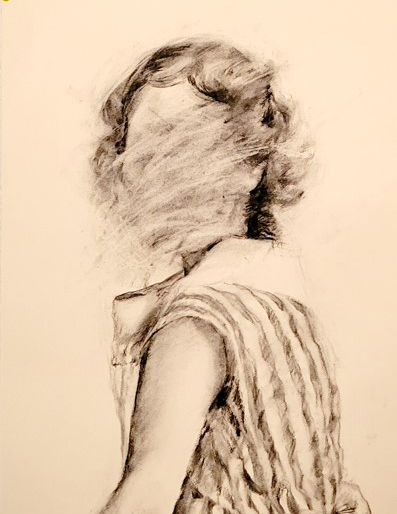My work is currently included in a fabulous, intelligent show at the Kingsgate Project Space in London through the month of March. This special show includes an catalog with an essay on the show, the artists, and the curatorial constructs that have formed it. Written by Mark Spelman, it is insightful, informative and highly entertaining. Below is the section on me and my contribution…which I wildly admire…
Deb is an older woman,
and as such invisible. I don’t subscribe to that idea, but I don’t have her experience of erasure both in the workplace and within wider social contexts. Since I’ve known her, Deb’s work has focused on historical representations of women, using references that focus superficially on their femininity but take no interest in their substance. She re-appropriates images of women from golden-age film promo and stock images that skirt around obscenity laws at the time by being on the right side of ‘glamour’. She subverts and empowers them, expresses unrepresented emotions – uncomfortable emotions – and uses materials, commonly associated through sexist stereotypes, to imbue them with political meaning.
Her series of Bag Lady works take reference from photographs of swimsuit models in the ‘50s, of beauty queen contests, and re-presents them with their heads covered by cheap paper bags, for me a concise criticism of the grotesque hunger of the male gaze on the one hand yet slightly mournful of the limitations of feminist emancipation under capitalism on the other. This is why we can’t have nice things. I find there is an uncomfortable contradiction in her fascination with perceptions of feminine beauty – a contradiction in me perhaps – in that on the one hand it makes comment on the commodification of a feminine ideal, the notions of sell-by-dates and the fetishisation of youthful vitality and value, but it also celebrates it. There is no contradiction there at all, it suggests. Why would there be? And then you realise that your own internal programming of how to look at and define these ideas comes from a position of some institutional imposition. There is a scrutiny of the tenuous notions of freedom in a lot of the work, of the true cost of ‘gifted’ rights, and the illusion that this constitutes some kind of freedom. There is an awareness of the duality of intent that is sold to us through encouragement of self-expression. Her work is saturated by loss, the kind that comes from the slow dissolution of comforting illusions, yet it is often executed with a breaking-point manner, like Miss Havisham ripping away her own curtains. The execution of her work is enviable; she is spare with her lines. There is an economy of expression within her work which lacks neurosis, something of which I am frankly jealous because of my own uptight applications of ink to paper. The way she can describe material with such minimalism makes me blush. It feels like there is a real comfort in her use of tools – they are something of an extension of her, which makes the description of discomfort expressed within them even more interesting to me. I don’t feel comfortable talking about Deb’s work, not because I don’t love it, I do, it’s why I’m so pleased she agreed to show it here. But because essentially my opinion of it is counter to its purpose. It doesn’t require me to talk over it, doesn’t need my opinion and my voicing of it almost feels like an affront to its autonomy.
But talk of it I have to, and my discomfort in doing so is part of its allure and potency.
The three works here are exceptional expressions of portraiture;
they seemingly embrace notions of traditional portraiture while completely vandalising the process. They take one of the most normalised and conditioning expressions of early representation – photographs from school yearbooks – and redefine them with a brutal exorcism and rejection of nostalgia. These works are biographical in more than just source; the young woman represented is Deb herself, her body poised in that familiar way of early school training; on display, presentable and positioned with a shoulder just-so, peering back toward the camera as many young girls are contrived to do. But the most sincere expression is the central most destructive one: the aggressive erasure of the central part of a portrait: the face. The purposeful scratching away with its auto-biographical anger, loathing, and possible sadness says more than a trite rendering of facial expression could ever do. It rejects representation, of presentation, of twee rendering. It demolishes sentimentality, literally, and damages itself in a manner that maybe says more than it wants to. I’m not sure whether the motivation behind the erasure is one of sadness at who one was, an anger over how one was treated, or just an expression of pain from having spent so much time having to contemplate and describe a part of you that is gone forever, but they are works of great political force. They are not-portraits and they speak loudly of a life lived, but from far down the line.
What Never Was
continues through March 30
www.kingsgateworkshops.org.uk
for the full text regarding the exhibit – copy and paste
https://drive.google.com/file/d/1GcPiPKklUkhA3fvYhOXcUBbeJzsv4XVW/view?usp=sharing
a very good read…
with many thanks to Mark Spelman and Kingsgate Project Space







